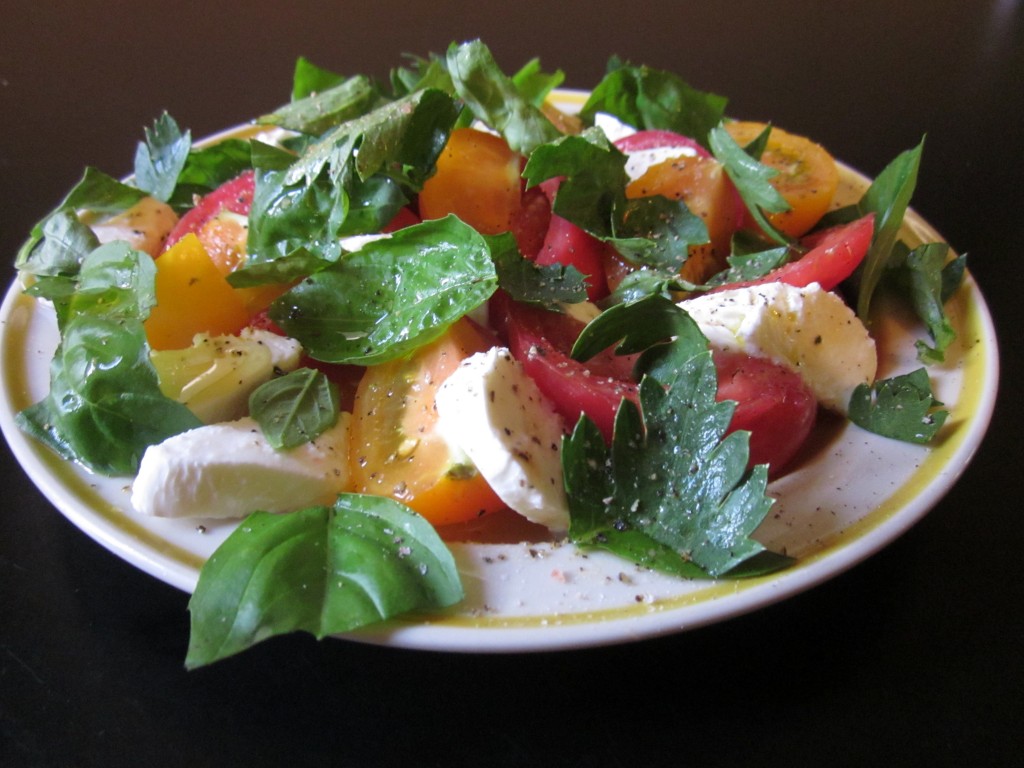Culture
The Hipster’s Cookbook: Heirloom Tomatoes

Every week in The Hipster’s Cookbook, Meghan Bongartz shows you how to make delicious food on a tight budget.
I have not turned my oven on in over a week. It’s been hot enough in Chicago (and, I think, the rest of the country as well) to fry an egg on the sidewalk, so I haven’t needed to–I’ve just had to get used to having some dirt and broken glass in my eggs. The texture is a little rough, but if you’re going for an earthy flavor I can’t think of a better way to get it.
Really, though, I don’t have air conditioning, and trying to bake anything over the past week would have been the cruelest kind of self-induced torture. Fortunately, this hasn’t been a problem because the heat wave coincided with local tomatoes coming ripe, so I’ve pretty much been eating those. I look forward to eating fresh, local tomatoes each summer the way small children look forward to Christmas and birthdays. When I was growing up, my dad basically grew a tomato garden: There was always space for other vegetables, but nothing else received quite the dedication that the tomato plants did. I have vivid memories of visiting multiple nurseries each spring to purchase as many varieties of tomato seedlings as possible. At that time, most garden centers carried mainly modern hybrids – which will still taste far better than grocery store tomatoes if they’re grown in your garden – but our favorites were always the bright pink Brandywines and the darker-hued Black Krims and Ananas Noirs. I didn’t know why; I just knew they tasted better and that it was exciting to have black tomatoes when they were supposed to be red.
Later, I learned that the tomatoes I loved so much were heirloom varieties. These are open-pollination, largely old-breed tomatoes that have not been genetically engineered in the same ways that the tomatoes you see at the supermarket are. I’m not going to get into a discussion about domesticating plants today because in the end, we have technically selected the traits of all the food (plant or animal) that we eat today. Suffice it to say that if you breed a tomato to ripen in a cardboard box instead of on the vine, it’s going to taste more than a little like cardboard itself. Heirloom tomatoes are sweeter, have a greater range of flavor, and come in more colors than you’ll ever find in commercially-grown varieties. The cost is that they have a shorter shelf life and are rarely, if ever, perfectly round because they aren’t bred for storage and shipping, but I think this is part of their charm. There are hundreds of types of heirloom tomatoes out there, many of which are amazing and some of which are rarely seen for a reason. If you’re curious about trying heirlooms, here are a few varieties to keep your eyes open for:
Black Cherry: This is my favorite miniature tomato. The purple and green fruit is typically on the large end for cherry tomatoes, and is sweet and fruity without being overpowering.
Green Zebra: I started growing these so that people wouldn’t steal my tomatoes off the plants (clearly there’s no way anyone would figure out that they’re ripe when green), but they’re also worth growing because they’re gorgeous in both appearance and flavor. Striped with lime green and yellow, they’re wonderfully tangy.
Sudduth’s Brandywine: Brandywines are a universal favorite for a reason, and Sudduth’s Strain is the most popular of them. These bright pink tomatoes are rich and sweet tasting – exactly what you would imagine a tomato should taste like.
Purple Cherokee: This is a larger dark tomato with a unique, earthy, almost smoky flavor. It’s incredibly juicy and refreshing, and is great for slicing.
Caspian Pink: This meaty slicing tomato is sweet and mild, and many people think it rivals the Brandywine in taste. Caspian Pinks can reach 2-3 pounds in size, so you can almost make a meal out of a single tomato.
Blondkopfchen: These grape-sized golden tomatoes are another favorite miniature tomato. They have a citrusy finish and are delicious for eating by the handful or mixed into larger dishes for a touch of sunshine.
While all of these will work perfectly well in cooked tomato dishes, and there are some excellent sauce-making heirlooms, the best way to enjoy tomatoes will always be straight off the vine. A simple tomato salad is a wonderful and easy way to showcase the tomatoes’ flavor, especially if you have a few varieties that you can mix together. For this version of the Caprese salad, I used a combination of Brandywine and Jaune Flamme tomatoes and added celery leaf for a little bite to counter the sweetness. Of course, what tomatoes you choose to use are up to you. This recipe makes enough salad for a meal for one person, but is easy to multiply to feed more people.
——
Caprese Salad with Celery Leaf
1 large or a mixture of small and medium tomatoes
3 oz fresh mozzarella cheese
¼ cup fresh basil
2 tbs fresh celery leaf
1 tbs olive oil
Freshly ground salt and pepper to taste
1) If using larger tomatoes, slice into pieces big enough for a bite or two. Cherry or grape tomatoes can remain whole or be halved. Slice mozzarella into bite-sized pieces and mix with the tomatoes on a plate.
2) Tear or roughly chop basil and celery leaf and arrange over tomatoes and cheese.
3) Drizzle with olive oil and sprinkle generously with salt and pepper.